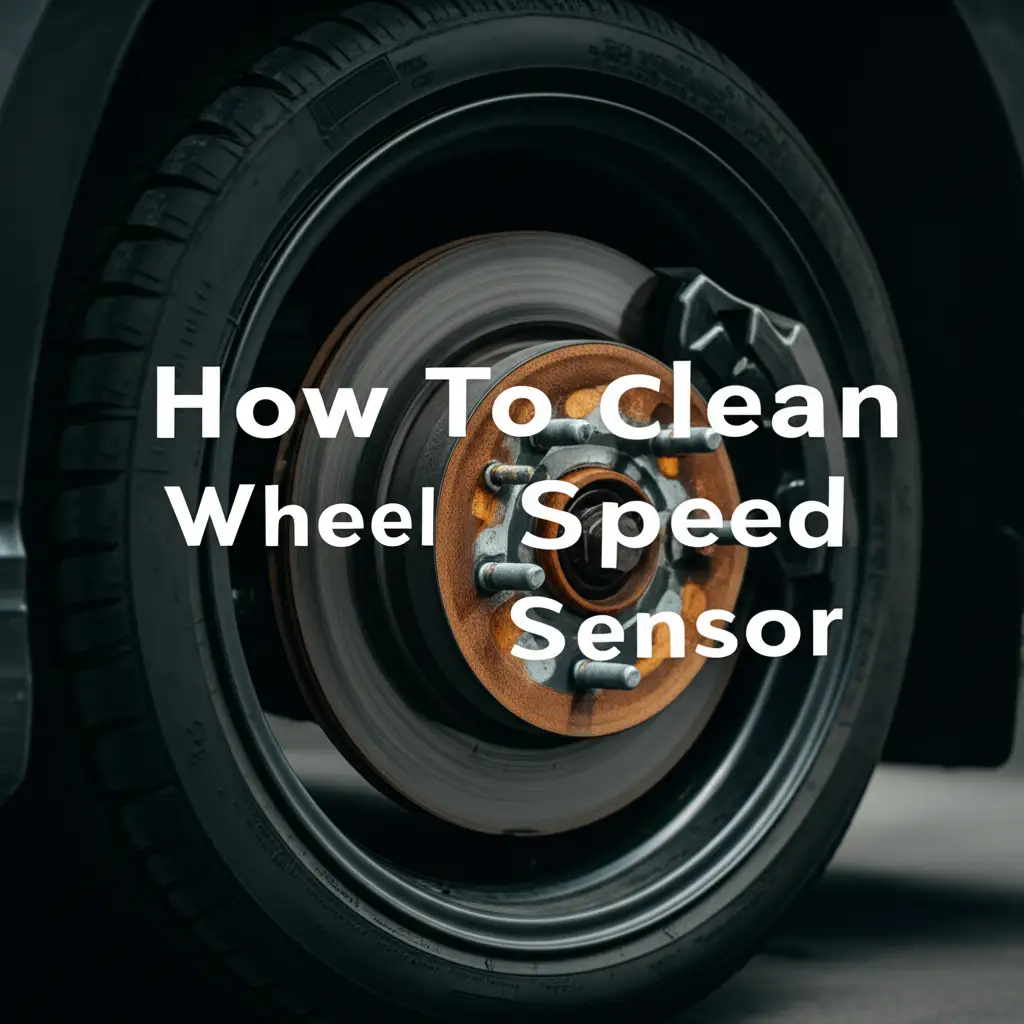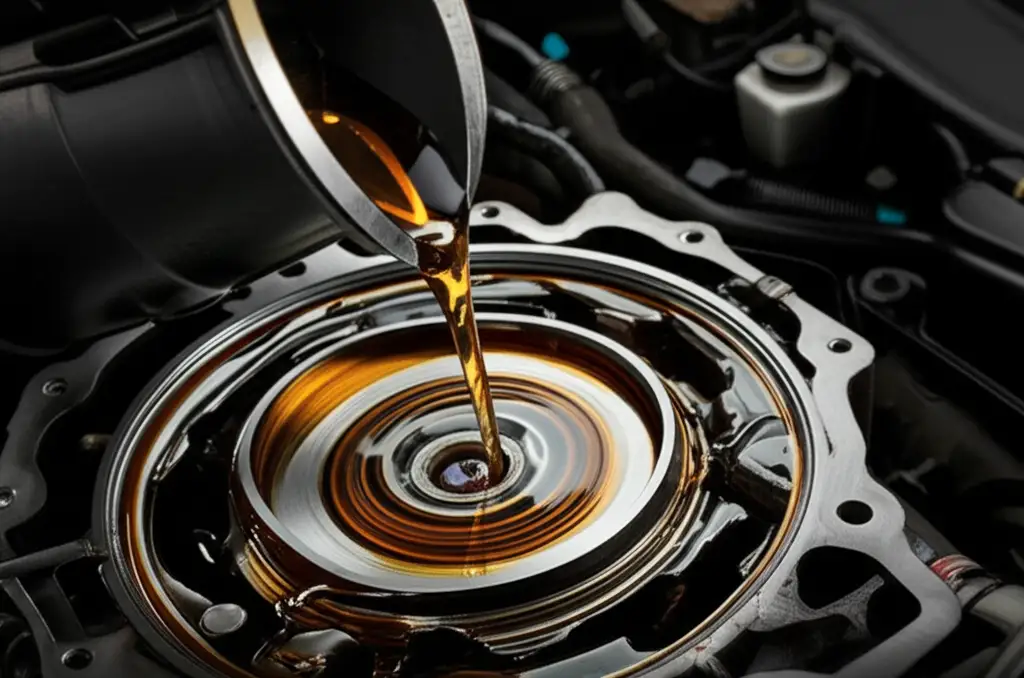· Automotive Maintenance · 15 min read
How To Clean Abs Sensor

Restore Your Brakes: How to Clean ABS Sensor Effectively
Has your ABS warning light suddenly appeared on your dashboard? This can feel alarming, especially when you know it relates to your vehicle’s braking system. Often, the issue is not a major component failure but a simple dirty sensor. A clean ABS sensor helps ensure safe braking and prevents costly repairs. Knowing how to clean an ABS sensor yourself can save you time and money.
I understand the frustration of seeing warning lights. Cleaning the ABS sensor is a practical skill for any car owner. This article guides you through the process. We will cover what an ABS sensor does, how to identify issues, and give you a clear, step-by-step cleaning method. You will learn about the necessary tools and best practices. By the end, you can handle this common car maintenance task with confidence.
Takeaway
- Locate Safely: Pinpoint your ABS sensors on each wheel, ensuring your car is stable.
- Remove Carefully: Disconnect the sensor wiring and unbolt the sensor from its housing.
- Clean Thoroughly: Use a gentle cleaner and brush to remove dirt and debris.
- Inspect Before Reinstall: Check the sensor and wiring for any damage before putting it back.
- Test Afterward: Drive your car to confirm the ABS light has gone off.
Cleaning an ABS (Anti-lock Braking System) sensor involves carefully removing it from its wheel hub location. You then use a non-abrasive cleaner and a soft brush to remove accumulated dirt, rust, or metal shavings from its tip. Reinstall the sensor securely to restore proper brake system function and turn off the warning light.
Understanding Your ABS Sensor’s Role in Vehicle Safety
The ABS sensor is a key part of your car’s safety system. It stands for Anti-lock Braking System sensor. This small device monitors the speed of each wheel. It sends this speed information to your car’s computer. The computer uses this data to prevent your wheels from locking up during hard braking. This allows you to steer and maintain control, even in slippery conditions. Without working ABS sensors, your car’s anti-lock braking system cannot function correctly.
A dirty sensor gives incorrect readings. This can cause the ABS warning light to turn on. It might also cause your traction control light to come on. Sometimes, the car’s computer gets confused by bad sensor data. This can lead to longer stopping distances. It can also cause the brake pedal to feel strange. Keeping these sensors clean is important for your safety on the road. A well-maintained sensor ensures your car’s safety systems work as designed.
The ABS sensor is often called a wheel speed sensor. It is typically mounted on the wheel hub or knuckle. It works with a tone ring or reluctor ring. This ring rotates with the wheel. The sensor detects the teeth on this ring. This detection creates a signal that tells the car’s computer how fast the wheel is spinning. When dirt or debris covers the sensor, it cannot accurately read the tone ring. This leads to faulty signals. This is why cleaning these sensors is a common solution. It fixes many ABS warning light issues.
Identifying When Your ABS Sensor Needs Attention
Your car gives signs when an ABS sensor needs cleaning. The most obvious sign is the ABS warning light turning on. This light usually appears on your dashboard. It looks like the letters “ABS” inside a circle or parentheses. This light indicates a problem with the anti-lock braking system. It does not always mean a major fault. A dirty sensor is a common cause.
Another sign is the traction control light coming on. Many cars integrate ABS with traction control systems. A fault in one system often affects the other. If both lights are on, a dirty ABS sensor is a strong possibility. You might also notice unusual braking behavior. The car could pull to one side during braking. The brake pedal might pulse when it should not. Sometimes, the car acts like it has locked up a wheel. These behaviors suggest the system gets bad information.
If you hear grinding noises from a wheel, check the sensor. This noise might indicate debris is trapped around the sensor or tone ring. Do not ignore these signs. A malfunctioning ABS system reduces your control during emergency braking. Cleaning the sensor first is a good diagnostic step. It often solves the problem without needing expensive parts. If these symptoms appear, consider checking your ABS sensors.
Essential Tools and Materials for ABS Sensor Cleaning
Before you begin cleaning your ABS sensor, gather the right tools. Having everything ready makes the job smoother. You will need safety gear, cleaning supplies, and basic automotive tools. I always make sure my workspace is prepared first. This prevents unnecessary delays.
Here is a list of what you will need:
- Safety Gear:
- Safety glasses: Protect your eyes from debris and cleaning solutions.
- Gloves: Protect your hands from dirt, grease, and chemicals.
- Lifting and Support Tools:
- Floor jack: To lift the vehicle.
- Jack stands: Essential for supporting the vehicle safely. Never work under a car supported only by a jack.
- Wheel chocks: To prevent the car from rolling.
- Basic Hand Tools:
- Socket wrench set: To remove lug nuts and sensor mounting bolts.
- Combination wrench set: May be needed for some sensor bolts.
- Wire brush or stiff-bristled brush: For cleaning stubborn dirt from the hub area.
- Soft-bristled brush or old toothbrush: For delicate cleaning of the sensor itself.
- Cleaning Supplies:
- Brake cleaner: A common choice for removing dirt, grease, and oil. It dries quickly and leaves no residue.
- Compressed air: To blow away loose dirt and dry the sensor.
- Clean rags or microfiber cloths: For wiping surfaces clean.
- Optional (but helpful) Tools:
- Penetrating oil: If bolts are rusted and difficult to remove.
- Anti-seize compound: To apply to bolts during reinstallation, preventing future rust.
- Diagnostic scan tool: To clear error codes after cleaning and confirm the fix.
Gathering these items before you start ensures you have everything at hand. This preparedness makes the cleaning process efficient and safe. Remember, working on your car requires caution. Proper tools are a part of that safety.
Step-by-Step Guide: How to Clean Your ABS Sensor
Cleaning your ABS sensor is a manageable DIY task. Following these steps ensures you do the job correctly and safely. I will walk you through each part of the process. This will help you restore your ABS system.
Safety First
Your safety is always the top priority. Before you start, park your car on a flat, solid surface. Engage the parking brake. Place wheel chocks behind the wheels that remain on the ground. For instance, if you work on the front, chock the rear wheels. Use a floor jack to lift the vehicle. Position the jack stands securely under the car’s frame. Never work under a car supported only by a jack. Remove the wheel closest to the sensor you want to clean. Store the lug nuts in a safe place.
Locate the Sensor
The ABS sensor sits near the wheel hub or steering knuckle. It often has an electrical wire running to it. There is usually one sensor for each wheel. Sometimes, it is integrated into the wheel bearing assembly. If you are unsure where it is, consult your car’s service manual. You might need to look behind the brake rotor or caliper. Look for a small plastic or metal sensor head. It points toward a toothed ring, which is the tone ring. This is the part that picks up wheel speed.
Remove the Sensor
Disconnect the electrical connector first. This connector often has a small tab you must press or pull. Be gentle, as plastic connectors can become brittle with age. Next, locate the bolt or clip holding the sensor in place. Most sensors are held by one small bolt. Use the correct socket or wrench to remove it. If the bolt is rusted, apply penetrating oil. Let it sit for a few minutes. Gently twist and pull the sensor out of its mounting hole. It might be stuck due to dirt or corrosion. Do not force it. Wiggle it gently. If it resists, spray more penetrating oil.
For more detailed information on cleaning similar automotive components, you might find our guide on how to clean wheel speed sensor helpful, as ABS sensors are often wheel speed sensors.
Inspect and Clean
Once the sensor is out, examine its tip. This is where dirt and metal shavings usually collect. Use a soft-bristled brush or an old toothbrush to gently scrub the sensor tip. Spray brake cleaner directly onto the sensor tip. This helps dissolve grease and grime. Do not use abrasive materials or harsh tools. They can damage the delicate sensor. Also, clean the mounting hole and the area around the tone ring. Use a wire brush for the hub area. Blow away loose debris with compressed air. Ensure the tone ring is also clean and free of rust or damage.
Cleaning other sensors on your vehicle can improve overall performance. For example, knowing how to clean map sensor or how to clean 02 sensor can help with engine efficiency and emissions.
Reinstallation
After cleaning, the sensor should be dry. Carefully insert the sensor back into its mounting hole. Ensure it sits flush and properly aligned. Reinsert and tighten the mounting bolt. Do not overtighten the bolt. Reconnect the electrical connector. Make sure it clicks into place. Reinstall the wheel. Tighten the lug nuts in a star pattern to the manufacturer’s specified torque. Lower the car off the jack stands. Remove the jack. Finally, remove the wheel chocks.
After installation, drive your car. The ABS light might turn off on its own after a few minutes of driving. If it stays on, you may need to use a diagnostic scan tool to clear the code. If the light persists, the sensor might be faulty, or there is another issue.
Common Causes of ABS Sensor Contamination
ABS sensors are exposed to harsh conditions. They sit near your wheels. This location makes them prone to contamination. Understanding what causes the dirt helps you prevent it. I have seen many sensors covered in various types of debris.
Here are the common culprits:
- Road Grime and Dirt: This is the most frequent cause. As you drive, your wheels kick up dirt, dust, and mud from the road. This debris sticks to the sensor and the tone ring. Over time, a thick layer can form. This layer blocks the sensor’s ability to read the tone ring accurately.
- Brake Dust: Brake pads wear down as you use your brakes. This creates fine metallic dust. This dust can accumulate on the sensor. Brake dust is conductive. It can interfere with the sensor’s electrical signals.
- Rust and Corrosion: Water, salt, and humidity cause rust. Metal components around the sensor, like the wheel hub or tone ring, can rust. Rust flakes can build up on the sensor. This affects its performance. Corrosion on the sensor itself can also impede its function.
- Metal Shavings: The tone ring itself or other nearby metallic parts can shed tiny metal shavings. These often stick to the sensor’s magnetic tip. These shavings can create an insulating layer or interfere with the magnetic field. This gives false readings.
- Road Debris: Small stones, twigs, or other general road debris can get lodged near the sensor. This can physically block the sensor’s line of sight to the tone ring. In some cases, larger debris can even damage the sensor.
- Grease and Oil: Leaks from nearby components, like axle seals or CV joints, can cover the sensor in grease or oil. This sticky residue attracts more dirt and forms a thick, insulating layer.
Regular inspections during tire rotations or brake checks can help spot contamination early. Addressing these causes promptly keeps your ABS system working well.
When to Clean vs. When to Replace Your ABS Sensor
It is important to know when a simple cleaning will fix your ABS sensor problem and when you need a new part. Cleaning is often the first step, but it is not always the solution. I always consider the symptoms and the sensor’s condition.
You should consider cleaning your ABS sensor if:
- The ABS warning light just came on: Especially if it happened suddenly after driving through mud, snow, or a dusty area.
- No physical damage is visible: The sensor looks intact, with no broken wires or cracks.
- There are clear signs of dirt or debris: When you remove the sensor, you see a build-up of grime, rust, or metal shavings on its tip.
- The problem is intermittent: The light comes on and off, suggesting a loose connection or a temporary blockage.
In these cases, cleaning is a cost-effective first attempt. It often resolves the issue.
However, you should consider replacing your ABS sensor if:
- Cleaning does not resolve the issue: After a thorough cleaning and reinstallation, the ABS light remains on or returns quickly.
- Physical damage is visible: The sensor housing is cracked, the wiring is frayed or broken, or the tip is chipped.
- The sensor shows signs of internal failure: A diagnostic scan tool specifically indicates an internal sensor circuit fault, not just a “low signal” or “intermittent signal.”
- The sensor is very old or corroded: Extremely corroded sensors might not respond to cleaning. The corrosion might have damaged the internal components.
- The tone ring is damaged: If the tone ring (the toothed wheel the sensor reads) is bent, broken, or heavily corroded, a new sensor might not fix the problem. You might need to replace the tone ring or the hub assembly.
Always perform a careful visual inspection first. If the sensor is physically damaged, cleaning will not help. Replacing it is necessary. If cleaning fails, then replacement is the logical next step.
Maintaining Your ABS Sensors for Longevity
Maintaining your ABS sensors goes beyond just cleaning them when a warning light comes on. Regular care helps prevent problems. This approach saves you from unexpected issues. I believe in proactive maintenance for all car components.
Here are ways to help your ABS sensors last longer:
- Regular Visual Inspections: When you rotate your tires or perform brake inspections, take a moment to look at the ABS sensors. Check for visible dirt buildup, damaged wires, or excessive rust near the mounting points. Early detection of grime can prevent future problems.
- Keep Wheel Wells Clean: Periodically spray down your wheel wells with a strong stream of water. This removes accumulated mud, salt, and road grime. Less debris in the wheel well means less debris getting to your sensors.
- Address Brake Dust Buildup: Brake dust is a major culprit for sensor contamination. If you notice heavy brake dust buildup on your wheels, consider cleaning them more often. You can use a dedicated wheel cleaner for this. This also helps other sensors. For example, cleaning similar components like a mass airflow sensor or even a hood latch sensor involves different techniques but highlights the importance of keeping critical automotive sensors clean.
- Check for Fluid Leaks: Leaking brake fluid, axle grease, or power steering fluid can coat sensors and attract dirt. If you spot any leaks, get them fixed promptly. This protects your sensors and other undercarriage components.
- Proper Installation During Repairs: If you have brake work or suspension work done, ensure mechanics handle ABS sensors carefully. They should install them correctly and not damage wiring.
- Use Anti-Seize Compound: When reinstalling sensors or any bolts around the wheel hub, apply a thin layer of anti-seize compound to the threads. This prevents corrosion. It makes future removal easier. This is especially helpful in areas where roads are salted in winter.
By following these maintenance tips, you reduce the chances of your ABS sensors failing due to contamination. This keeps your braking system reliable. It also avoids the hassle and cost of frequent repairs.
FAQ Section
Q1: Can I drive my car with the ABS light on?
Driving with the ABS light on is generally not recommended. Your anti-lock braking system might not work in an emergency. Your regular brakes still function, but you lose the ABS feature. This increases stopping distances and risk of skidding, especially on slippery surfaces. It is best to address the issue quickly.
Q2: How long does it take to clean an ABS sensor?
Cleaning an ABS sensor usually takes about 30-60 minutes per wheel. This includes jacking up the car, removing the wheel, cleaning the sensor, and reassembling everything. The time varies based on how easily the sensor comes out and how much corrosion is present.
Q3: What type of cleaner is best for an ABS sensor?
Brake cleaner is the best choice for ABS sensors. It is designed to remove grease, oil, and dirt quickly. Brake cleaner evaporates fast and leaves no residue. Avoid using harsh solvents or abrasive cleaners. These can damage the sensor’s delicate electronic components.
Q4: Will cleaning my ABS sensor turn off the ABS light immediately?
The ABS light might turn off immediately after cleaning and reinstallation. Sometimes, it needs a short drive (a few minutes) for the car’s computer to re-read the sensor. If the light stays on, you may need a diagnostic scan tool to clear the error code. If the light persists, the sensor might be faulty.
Q5: Can a dirty ABS sensor cause other dashboard lights to come on?
Yes, a dirty ABS sensor can cause other dashboard lights to illuminate. The most common additional light is the traction control light. This is because ABS and traction control systems often share sensor data. A faulty signal from the ABS sensor can confuse both systems, triggering multiple warnings.
Conclusion
A clean ABS sensor is essential for your vehicle’s safety. It ensures your anti-lock braking system works correctly. Knowing how to clean an ABS sensor yourself empowers you to handle a common car issue. We have covered the function of these important sensors, how to spot problems, and the exact steps for cleaning them. You also learned about common causes of contamination and maintenance tips.
Taking the time to clean these sensors can save you from potential hazards on the road. It can also prevent expensive diagnostic fees or part replacements. Regular maintenance of your ABS sensors is a smart part of car ownership. Remember, safety always comes first. If you are ever unsure, consult a professional mechanic. But with this guide, you now have the knowledge to tackle this task. Drive safely, knowing your ABS system is ready when you need it most.
- ABS sensor cleaning
- wheel speed sensor
- car maintenance
- brake system repair
- DIY car care




